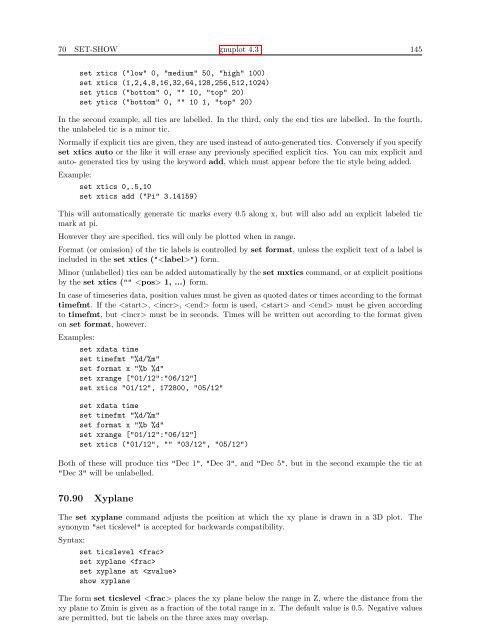gnuplot documentation
gnuplot documentation
gnuplot documentation
You also want an ePaper? Increase the reach of your titles
YUMPU automatically turns print PDFs into web optimized ePapers that Google loves.
70 SET-SHOW <strong>gnuplot</strong> 4.3 145<br />
set xtics ("low" 0, "medium" 50, "high" 100)<br />
set xtics (1,2,4,8,16,32,64,128,256,512,1024)<br />
set ytics ("bottom" 0, "" 10, "top" 20)<br />
set ytics ("bottom" 0, "" 10 1, "top" 20)<br />
In the second example, all tics are labelled. In the third, only the end tics are labelled. In the fourth,<br />
the unlabeled tic is a minor tic.<br />
Normally if explicit tics are given, they are used instead of auto-generated tics. Conversely if you specify<br />
set xtics auto or the like it will erase any previously specified explicit tics. You can mix explicit and<br />
auto- generated tics by using the keyword add, which must appear before the tic style being added.<br />
Example:<br />
set xtics 0,.5,10<br />
set xtics add ("Pi" 3.14159)<br />
This will automatically generate tic marks every 0.5 along x, but will also add an explicit labeled tic<br />
mark at pi.<br />
However they are specified, tics will only be plotted when in range.<br />
Format (or omission) of the tic labels is controlled by set format, unless the explicit text of a label is<br />
included in the set xtics ("") form.<br />
Minor (unlabelled) tics can be added automatically by the set mxtics command, or at explicit positions<br />
by the set xtics ("" 1, ...) form.<br />
In case of timeseries data, position values must be given as quoted dates or times according to the format<br />
timefmt. If the , , form is used, and must be given according<br />
to timefmt, but must be in seconds. Times will be written out according to the format given<br />
on set format, however.<br />
Examples:<br />
set xdata time<br />
set timefmt "%d/%m"<br />
set format x "%b %d"<br />
set xrange ["01/12":"06/12"]<br />
set xtics "01/12", 172800, "05/12"<br />
set xdata time<br />
set timefmt "%d/%m"<br />
set format x "%b %d"<br />
set xrange ["01/12":"06/12"]<br />
set xtics ("01/12", "" "03/12", "05/12")<br />
Both of these will produce tics "Dec 1", "Dec 3", and "Dec 5", but in the second example the tic at<br />
"Dec 3" will be unlabelled.<br />
70.90 Xyplane<br />
The set xyplane command adjusts the position at which the xy plane is drawn in a 3D plot. The<br />
synonym "set ticslevel" is accepted for backwards compatibility.<br />
Syntax:<br />
set ticslevel <br />
set xyplane <br />
set xyplane at <br />
show xyplane<br />
The form set ticslevel places the xy plane below the range in Z, where the distance from the<br />
xy plane to Zmin is given as a fraction of the total range in z. The default value is 0.5. Negative values<br />
are permitted, but tic labels on the three axes may overlap.

















